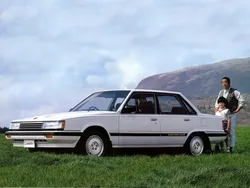

Toyota Camry - Generation 1 V10 Overview
Explore the Toyota Camry and its first generation (V10). Discover details about this classic model celebrated for its reliability in Portugal.
The Toyota Camry is one of the most recognizable and reliable sedans on the market today. But many enthusiasts and casual drivers might not be familiar with its origins. The first generation of the Camry, known a...
Technical Specifications
Select Version
Dimensions
Engine
Driving
Others
History and Features
Mycarro AI
Apr 27, 2025
The Toyota Camry is one of the most recognizable and reliable sedans on the market today. But many enthusiasts and casual drivers might not be familiar with its origins. The first generation of the Camry, known as the V10, was launched in 1982 and set the stage for what would become a mainstay in the automotive industry. This article will explore the design, features, engine options, and legacy of the Toyota Camry Generation 1.
Design and Features
In its inaugural launch, the Toyota Camry was designed as a compact car that offered a comfortable and roomy interior compared to other vehicles in its segment. The first-generation Camry adopted a sleek and straightforward design with smooth lines and a modest yet modern visual appeal. The sedan had a unibody construction and measured approximately 4,460 mm in length, making it both practical and user-friendly.
Inside, the V10 generation prioritized driver and passenger comfort. With an ergonomic cabin layout, the Camry offered spacious seating for up to five adults, which many small cars of that era could not achieve. The interior boasted a mix of soft-touch materials and durable plastics that gave it an upscale feel for a compact car. Standard features included vinyl upholstery, a four-speaker AM/FM radio, and optional air conditioning—all amenities that added to its appeal.
Engine Options
The first-generation Camry was equipped with two engine options that catered to different needs and preferences. The base model featured a 2.0-liter inline-four engine, producing approximately 105 horsepower. This engine provided sufficient power for daily driving while maintaining excellent fuel efficiency, which was critical during an era when fuel economy was a significant concern for many drivers.
For those seeking more performance, Toyota offered a 2.5-liter V6 option. This engine generated around 145 horsepower, allowing the Camry to deliver a more spirited driving experience. Both engines were paired with a standard five-speed manual transmission or an optional four-speed automatic, offering drivers a choice based on their driving style.
Safety and Reliability
Toyota’s reputation for reliability began to solidify during the V10 generation. The Camry was built with a focus on quality, and extensive testing ensured both performance and longevity. Although safety features were more rudimentary by today's standards, the Camry did include features such as crumple zones and a sturdy construction that helped protect occupants during an accident.
As consumers began to prioritize reliability and low maintenance costs, the Camry gained a loyal following. Many first-generation models remain on the road today, a testament to Toyota's engineering prowess during this era.
Market Reception
Upon its release, the Toyota Camry was met with positive reviews, earning praise for its spacious interior, comfortable ride, and fuel efficiency. It appealed to a wide consumer base, including families, commuters, and young professionals. The combination of quality construction and sensible pricing helped establish the Camry as one of the top choices in the compact car market.
The V10 generation’s success can also be attributed to Toyota's reputation in the automotive landscape during the early 1980s. As competition grew fiercer, the Camry stood out as a reliable and customer-friendly option, making it a popular choice for buyers looking for a practical sedan.
Evolution into Future Generations
Following the V10’s success, Toyota turned its attention to refining and improving the Camry for future generations. The subsequent generations introduced enhanced features, increasing engine options, and a focus on technology integration that would set the stage for the modern Camry. However, it's essential to recognize the impact that the first-generation model had on establishing a legacy of durability and reliability.
In conclusion, the Toyota Camry Generation 1 (V10) is an essential part of automotive history. Its combination of a practical design, reliable performance, and focus on customer satisfaction helped pave the way for the Camry's future success. As the model continues to thrive through subsequent generations, the first-generation Camry remains a cornerstone of Toyota's reputation for building quality vehicles that stand the test of time.
